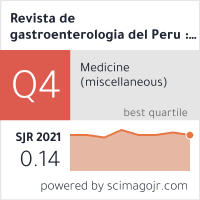The clinical importance of serrated lesions of the colorectum
DOI:
https://doi.org/10.47892/rgp.2013.332.220Palabras clave:
Colorectal neoplasms, Colon, RectumResumen
Colorectal cancer (CRC) is the third most common cancer in the world. Fortunately, it is also proven to be one of the most preventable cancers, in large part due to the utilization of CRC screening. Historically, it was believed that the adenomatous polyp was the only precursor to carcinoma of the colorectum. Within the last decade, it has been shown that approximately 20-30% of sporadic colon cancers arise through a distinct molecular pathway called CpG Island Methylation (CIMP) which is due to widespread DNA methylation. There is strong evidence that serrated polyps are the precursor lesions for colon cancers arising through the CIMP pathway.Descargas
Los datos de descargas todavía no están disponibles.
Métricas
Cargando métricas ...
Descargas
Publicado
08.08.2017
Cómo citar
1.
Burke C. The clinical importance of serrated lesions of the colorectum. Rev Gastroenterol Peru [nternet]. 8 de agosto de 2017 [citado 18 de diciembre de 2025];33(2):147-51. isponible en: https://revistagastroperu.com/index.php/rgp/article/view/220
Número
Sección
ARTÍCULOS DE REVISIÓN
Licencia
Revista de Gastroenterología del Perú by Sociedad Peruana de Gastroenterología del Perú is licensed under a Licencia Creative Commons Atribución 4.0 Internacional..
Aquellos autores/as que tengan publicaciones con esta revista, aceptan los términos siguientes:
- Los autores/as conservarán sus derechos de autor y garantizarán a la revista el derecho de primera publicación de su obra, el cuál estará simultáneamente sujeto a la Licencia de reconocimiento de Creative Commons que permite a terceros compartir la obra siempre que se indique su autor y su primera publicación esta revista.
- Los autores/as podrán adoptar otros acuerdos de licencia no exclusiva de distribución de la versión de la obra publicada (p. ej.: depositarla en un archivo telemático institucional o publicarla en un volumen monográfico) siempre que se indique la publicación inicial en esta revista.
- Se permite y recomienda a los autores/as difundir su obra a través de Internet (p. ej.: en archivos telemáticos institucionales o en su página web) antes y durante el proceso de envío, lo cual puede producir intercambios interesantes y aumentar las citas de la obra publicada. (Véase El efecto del acceso abierto).
















 2022
2022 